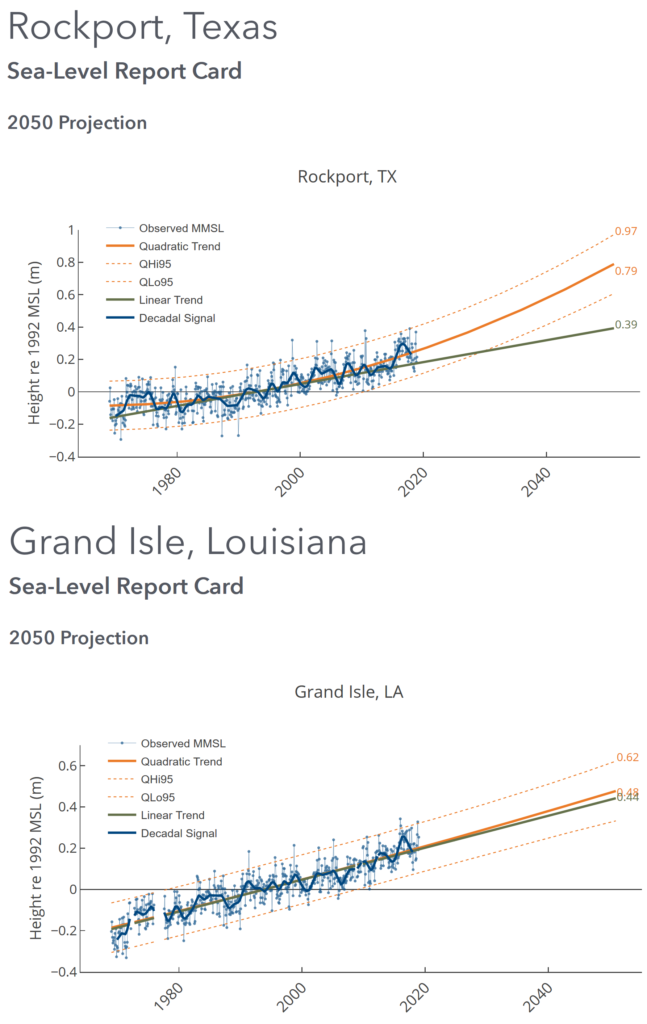Highest sea level rises in U.S. are in Texas and Louisiana, annual report finds

By Dr. Jeff Masters
11 March 2019
(Weather Underground) – Texas and Louisiana have the highest rates of sea level rise in the U.S., with Grand Isle, Louisiana (7.75 mm or 0.305 inches per year) topping the list, according to the annual sea level “report card” from researchers at William & Mary’s Virginia Institute of Marine Science. Rockport, Texas (south of Galveston) had the highest acceleration rate (0.240 mm/year2), due to rising seas combined with subsiding land (caused by such things as natural geological processes, ground water pumping, and oil industry activity).
Many sea level rise predictions rely on observations of current sea level rise (currently about 3.1 mm/year globally) to project future water levels. However, the researchers argued that since sea level rise is accelerating, a more valid forecast can be made by assuming the current acceleration rate will continue through 2050. Research published in 2018 found that global sea level rise has accelerated by 0.084 mm/year2 over the past 25 years, and 18 of the 32 U.S. tide gauges from the sea level report card had acceleration rates greater than the global average.
If Rockport’s observed 2018 acceleration rate were to hold, the sea level report card predicted 0.78 meters (2.6 feet) of sea level rise by 2050, relative to 1992 levels—the highest predicted rise of any of the 32 locations studied. Predicted sea level rise at all other stations on the Atlantic coast, based on current rates of acceleration, ranged from 0.7 to 1.6 feet. Predicted rises along the Pacific coast were lower, ranging from -0.3 to 0.7 feet from California to Washington. Relative sea level is falling everywhere in Alaska, due to crustal rebound from melting glaciers.
Coastal flooding is erasing billions in property values from sea level rise
A February analysis by First Street Foundation, a non-profit focused on creating awareness on the economic dangers of climate change-enhanced high tide flooding, estimated that property value losses from coastal flooding in 17 states from Maine to Mississippi were nearly $16 billion from 2005 to 2017. Florida, New Jersey, New York and South Carolina, with more than $1 billion in losses, topped the list. The actual losses are probably higher, since their model did not include losses from hurricanes or heavy rains. As explained in an excellent article by Neil Katz at weather.com, the losses do not represent actual depreciation in real estate values, which are still increasing in coastal areas subjected to high tide flooding. What’s being estimated are potential increases since 2005 that were never realized. Increasingly flood-prone coastal areas are rising in value more slowly than adjacent areas that do not flood. The article also detailed the aggressive actions cities like Ocean City, MD, and Miami Beach are taking to stay ahead of sea level rise.
A February analysis by First Street Foundation, a non-profit focused on creating awareness on the economic dangers of climate change-enhanced high tide flooding, estimated that property value losses from coastal flooding in 17 states from Maine to Mississippi were nearly $16 billion from 2005 to 2017. Florida, New Jersey, New York and South Carolina, with more than $1 billion in losses, topped the list. The actual losses are probably higher, since their model did not include losses from hurricanes or heavy rains. As explained in an excellent article by Neil Katz at weather.com, the losses do not represent actual depreciation in real estate values, which are still increasing in coastal areas subjected to high tide flooding. What’s being estimated are potential increases since 2005 that were never realized. Increasingly flood-prone coastal areas are rising in value more slowly than adjacent areas that do not flood. The article also detailed the aggressive actions cities like Ocean City, MD, and Miami Beach are taking to stay ahead of sea level rise. [more]
Highest Sea Level Rises in U.S. are in Texas and Louisiana, Annual Report Finds